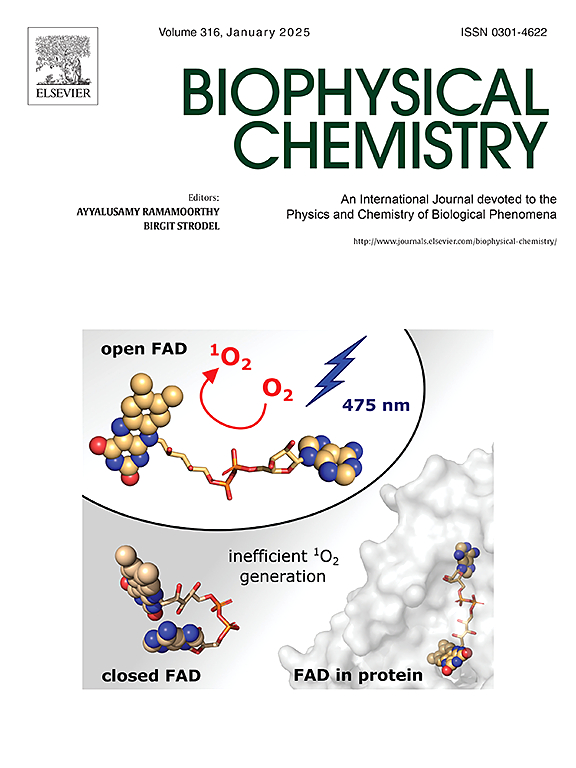Unbiased clustering of residues undergoing synchronous motions in proteins using NMR spin relaxation data
IF 2.2
3区 生物学
Q2 BIOCHEMISTRY & MOLECULAR BIOLOGY
引用次数: 0
Abstract
Biological macromolecules are dynamic entities that transition between various conformational states, often playing a vital role in biological functions. Their inherent flexibility spans a broad range of timescales. Motions occurring within the microsecond to millisecond range are especially important, as they are integral to processes such as enzyme catalysis, folding, ligand binding, and allostery. NMR Carr-Purcell-Meiboom-Gill (CPMG) relaxation dispersion measurements are the preferred method for characterizing macromolecular motions at atomic resolution. However, it is still uncertain whether the functional motions of multiple residues in macromolecules need to be coordinated and/or synchronized within the protein matrix in order to perform the desired function. Here, we illustrate an unbiased method to analyze NMR relaxation dispersion and identify dynamic clusters of residues that fluctuate on similar timescales within proteins. The method requires relaxation dispersion data for backbone amides or side-chain methyl groups, which are globally fitted using the Bloch-McConnell equations for each pair of residues. The goodness of the pairwise fitting serves as a metric to construct two-dimensional synchronous dynamics (SyncDyn) maps, allowing us to identify residue clusters whose dynamics are influenced by ligand binding. We applied our method to the catalytic subunit of the cAMP-dependent protein kinase A (PKA![]() C) and the T17A mutant of ribonuclease A (RNAse A). The SyncDyn maps for PKA-C showed distinct clusters of residues located in critical allosteric sites. Nucleotide binding activates the movement of residues at the interface between the two lobes and also those distal to the active site. In the case of RNAse A, the SyncDyn maps show that residues fluctuating with the same time scale are interspersed in both lobes of the enzyme. Overall, our approach eliminates arbitrary manual selection of residues for dynamic clustering and objectively identifies all possible residue pairs that fluctuate synchronously, i.e. on the same timescale.
C) and the T17A mutant of ribonuclease A (RNAse A). The SyncDyn maps for PKA-C showed distinct clusters of residues located in critical allosteric sites. Nucleotide binding activates the movement of residues at the interface between the two lobes and also those distal to the active site. In the case of RNAse A, the SyncDyn maps show that residues fluctuating with the same time scale are interspersed in both lobes of the enzyme. Overall, our approach eliminates arbitrary manual selection of residues for dynamic clustering and objectively identifies all possible residue pairs that fluctuate synchronously, i.e. on the same timescale.

利用核磁共振自旋弛豫数据研究蛋白质中同步运动残基的无偏聚类
生物大分子是在不同构象状态之间转换的动态实体,在生物功能中起着至关重要的作用。它们固有的灵活性跨越了广泛的时间尺度。发生在微秒到毫秒范围内的运动尤为重要,因为它们是酶催化、折叠、配体结合和变构等过程的组成部分。核磁共振carr - purcell - meiboomm - gill (CPMG)弛豫色散测量是原子分辨率表征大分子运动的首选方法。然而,目前尚不清楚大分子中多个残基的功能运动是否需要在蛋白质基质内协调和/或同步才能发挥预期的功能。在这里,我们展示了一种无偏的方法来分析核磁共振弛豫色散和识别在蛋白质内类似时间尺度上波动的动态残基簇。该方法需要主链酰胺或侧链甲基的弛豫色散数据,这些数据使用Bloch-McConnell方程对每对残基进行全局拟合。两两拟合的优度可作为构建二维同步动力学(SyncDyn)图的度量,使我们能够识别其动力学受配体结合影响的残基簇。我们将该方法应用于camp依赖性蛋白激酶A (PKAC)的催化亚基和核糖核酸酶A (RNAse A)的T17A突变体。PKA-C的SyncDyn图谱显示了位于关键变构位点的不同残基簇。核苷酸结合激活两个裂片交界面的残基运动,也激活活性位点远端的残基运动。以RNAse A为例,SyncDyn图谱显示,以相同时间尺度波动的残基散布在酶的两个裂片中。总的来说,我们的方法消除了动态聚类残基的任意手动选择,并客观地识别了所有可能同步波动的残基对,即在同一时间尺度上。
本文章由计算机程序翻译,如有差异,请以英文原文为准。
求助全文
约1分钟内获得全文
求助全文
来源期刊

Biophysical chemistry
生物-生化与分子生物学
CiteScore
6.10
自引率
10.50%
发文量
121
审稿时长
20 days
期刊介绍:
Biophysical Chemistry publishes original work and reviews in the areas of chemistry and physics directly impacting biological phenomena. Quantitative analysis of the properties of biological macromolecules, biologically active molecules, macromolecular assemblies and cell components in terms of kinetics, thermodynamics, spatio-temporal organization, NMR and X-ray structural biology, as well as single-molecule detection represent a major focus of the journal. Theoretical and computational treatments of biomacromolecular systems, macromolecular interactions, regulatory control and systems biology are also of interest to the journal.
 求助内容:
求助内容: 应助结果提醒方式:
应助结果提醒方式:


